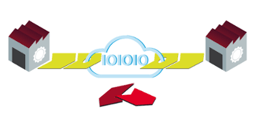The Supply Chain Manager’s Guide to the Cloud
Jesse Kelber - August 13, 2020

 The cloud is maturing. The technology that underpins it is already solid--it’s the infrastructure that allows for high-speed connectivity that’s finally caught up and is accelerating the digital transformation across sectors. The recent roll-out of widespread 5G access has done wonders to advance the notion that the cloud is here to stay. The mix of flexibility, reasonable cost, and increased ROI should be enough to make even the most hardened skeptic stand up and take notice. This article is meant as a set of guideposts, something to help get you started down the road to your own cloud implementation. Use the areas we discuss as general targets or as subjects to be researched further as you determine the details of when, where, and how to take your supply chain management into the cloud.
The cloud is maturing. The technology that underpins it is already solid--it’s the infrastructure that allows for high-speed connectivity that’s finally caught up and is accelerating the digital transformation across sectors. The recent roll-out of widespread 5G access has done wonders to advance the notion that the cloud is here to stay. The mix of flexibility, reasonable cost, and increased ROI should be enough to make even the most hardened skeptic stand up and take notice. This article is meant as a set of guideposts, something to help get you started down the road to your own cloud implementation. Use the areas we discuss as general targets or as subjects to be researched further as you determine the details of when, where, and how to take your supply chain management into the cloud.
The Cloud Offers the Ultimate in Infrastructure Flexibility
One of the primary hurdles supply chain managers run into when developing a digital transformation strategy is the lack of infrastructure at many locations. Warehouses don’t often have cat6 cabling already laid, after all. With the explosion in IoT devices coming to market that rely on cloud technology, it’s become easier than ever to retrofit facilities enough to take advantage of the insights these sensors can provide to streamline production, reduce maintenance costs, and improve forecast accuracy. The decentralized nature of cloud tech is where it shines--it means everyone can connect directly to your SCM solution no matter where in the value chain, or where on the globe, they happen to be.
Making the investment in a solid base of SCM infrastructure in the cloud now will not only bring immediate gains, it also sets you up well to make use of technologies that are just emerging on the scene. Things like edge computing are set to have a huge impact on companies’ ability to apply advanced analytics in real time for actionable insights that can be applied instantly. There is a caveat to all this goodness, of course, which is the fact that SCM often exists in a gray area of sorts. As we mentioned earlier, not all facilities are capable of being retrofitted for the current round of Industry 4.0 solutions. In these cases, a mix of on-prem and cloud can be used to reap as much reward as possible while waiting for future developments to become available that can take your SCM to the next level.
Cloud Investment and ROI
There are two aspects to take into account here, initial costs and TCO. In the initial cost category, cloud beats on-premises hands down. For an on-premises deployment, you’re required to build out the infrastructure, purchase the servers, and staff the facility with IT people who can maintain it all. On the other hand, with a cloud deployment, your initial layout consists solely of your first month’s subscription payment. The bottom line on TCO is that with the cloud your costs are more predictable, since you don’t have to worry about unexpected maintenance or replacement costs like you would with servers you own. Your monthly subscription covers the cloud providers’ costs for maintenance as well as upgrades as it’s in their best interest to always have the latest and greatest hardware for their clients.
Scalability Is Crucial in Uncertain Times
The retail market is in turmoil right now, and manufacturers are feeling the fallout. When you have a slow month, on-premises systems are still consuming power and taking employee time to monitor and maintain. On the other hand, in the cloud, your provider can simply throttle bandwidth and reduce processor access to save money. Then when things turn around, your on-premises systems will be taxed to the max increasing the likelihood of crashes and downtime, while your cloud systems can simply have the tap opened again and add some processing capacity. And all it costs you is the slight bump to a higher subscription level to pick up the slack. As a bonus, as your company grows, all you need to do to scale your cloud solutions is ask your provider to bump you up another step or possibly move to a dedicated instance rather than a shared one and you’re good to go.
SCM: An Early Adopter of Cloud Technology
ERP systems were among the first to take advantage of cloud tech. The collaborative nature of these tools made them a great candidate for the flexibility and ease of access allowed by moving to the cloud. At this point, there’s a robust and competitive market for these solutions. Picking the right one will come down to you knowing your needs along with the tools your up- and downstream partners are using to ensure compatibility. Lack of access to a needed tool can lead to shadow IT, i.e. systems that are outside of the control of your IT department and thus cause data silos and other bottlenecks. These disruptions and the headaches that ensue can drive up expenses and increase production delays.
For the Ultimate in End-to-End Visibility—Enter the Cloud
By adopting a combination of cloud solutions and a postmodern ERP mindset, you can overcome many of the hurdles caused by a lack of supply chain visibility. No single solution can deliver everything you need, but a cloud ERP offers the integrations you need to ensure everyone from planning to shipping to fulfillment has access to the data they need, when they need it. Add integrations with your partners, and you’re well on your way to the dream of all supply chain managers: complete end-to-end visibility and all the benefits it brings.
The digital transformation of the supply chain is gaining speed. The technological advances represented by Industry 4.0 are, by and large, powered by concurrent advances in the tech that underpins the cloud. Increasing connectivity speeds, distributed infrastructure, and the IoT are leading the charge and are behind the emergence of further solutions that will bring SCM into the 21st-century and ensure it’s ready to carry you well into the foreseeable future.
LATEST POSTS
- Understand Circular Economy in The Manufacturing Industry
- How Can Industry 4.0 IT Integration Be Achieved Smoothly?
- The Significance of Order Sequencing in Discrete Manufacturing
- How to improve your Supply Chain Management: The Power of Control Towers
- Optimizing Human Resource Scheduling in Manufacturing: A Technological Approach



